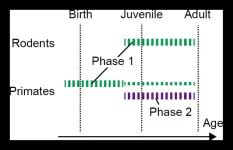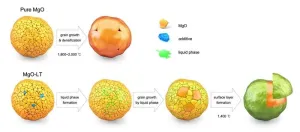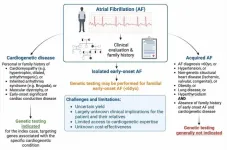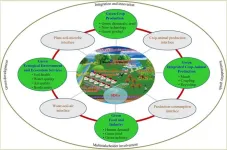(Press-News.org) The first analysis of how synaptic proteins change during early development reveals differences between mice and marmosets but also what's different in individuals with autism spectrum disorders. The Kobe University findings offer first insights into the mechanism behind synaptic development and open up routes for research on possible treatments.
Given that synapses are the connections between our brain cells, one might think that having as many of these as possible is a good thing. However, primate brains do something unexpected: After early childhood, the connections between brain cells start to decrease in a process called “synaptic pruning.” Surprisingly, we know very little about the molecular mechanism behind how synapses change as brains mature and this is also a hurdle for the development of cures to neuropsychological disorders such as the autism spectrum disorder.
Both recent developments in the ability to analyze complex protein assemblies and the recent availability of marmosets as non-human primate model organisms for studies on the brain enabled Kobe University neuroscientist TAKUMI Toru to tackle this knowledge gap. He explains, “The Collaboration with experts in proteomics and non-human primate brain has been a critical factor for enabling this study. Also, we have established an analytical pipeline to compare multiple biological data sets using the latest statistical and bioinformatics tools, which was another crucial element.” With this, they focused their studies on the analysis of a protein agglomeration found on the signal-receiving side of synapses, the so-called “postsynaptic density,” as it has become clear in previous studies that its constituents are key to the development of small mushroom-shaped protrusions on the signal-receiving cells where synapses are formed.
Their results, published in the journal Nature Communications, are science’s first look at what is happening at the protein level in synapses during brain development in the first weeks, months and years after birth. The Kobe University-led research team identified a group of proteins that are produced more and others that are produced less as time passes and could confirm that this is due to changes in gene regulation. They also found that the timing of this regulation is different in mice and marmosets: What happens in mice two weeks after birth happens before or around birth in marmosets. In addition, marmosets have a second phase of protein changes that mice don’t have. “This may be related to the evolutionary differences between rodent and primate brains,” comments KAIZUKA Takeshi, the first author of the paper, also in respect to the process of synaptic pruning.
Takumi’s interest didn’t stop there. Knowing that the development of autism spectrum disorder is connected to developmental immaturities of synapses, they investigated what this means on the level of the proteins his group had identified to be connected to synapse development. And indeed, they found that the genes reported to be expressed differentially in autism patients also feature prominently in their data. “These data suggest that the postsynaptic density in autism spectrum disorder patients is relatively similar to that in the prenatal or neonatal period compared to healthy subjects,” the researchers write in the study. Being thus able to construct hypotheses on the molecular mechanism behind the emergence of the disorder, this might open up the path for the development of treatments.
Takumi sums up the implications of this study. “Synapse development is a crucial issue to consider in the maturation of brains. Its abnormalities are related to neuropsychiatric disorders, including autism spectrum disorders and schizophrenia. The proteome datasets we provided are important for considering molecular mechanisms of synapse development and the difference between rodents and primates.”
This research was funded by the Japan Society for the Promotion of Science (grants 16H06316, 16H06463, 18K14830, 21H04813, 23H04233, 23KK0132 and 16J04376), the Japan Agency for Medical Research and Development (grants JP21wm0425011 and JP20dm0207001), the Japan Science and Technology Agency (grants JPMJMS2299 and JPMJMS229B), the National Center of Neurology and Psychiatry (grant 30-9), the Takeda Science Foundation, and the Taiju Life Social Welfare Foundation. It was conducted in collaboration with researchers from the RIKEN Center for Brain Science, the RIKEN Center for Sustainable Resource Science, the Max Planck Institute for Experimental Medicine, Hokkaido University and Keio University.
Kobe University is a national university with roots dating back to the Kobe Commercial School founded in 1902. It is now one of Japan’s leading comprehensive research universities with nearly 16,000 students and nearly 1,700 faculty in 10 faculties and schools and 15 graduate schools. Combining the social and natural sciences to cultivate leaders with an interdisciplinary perspective, Kobe University creates knowledge and fosters innovation to address society’s challenges.
END
Synaptic protein change during development offers clues on evolution and disease
2024-03-28
ELSE PRESS RELEASES FROM THIS DATE:
How commercial rooftop solar power could bring affordable clean energy to low-income homes
2024-03-28
Lower-income communities across the United States have long been much slower to adopt solar power than their affluent neighbors, even when local and federal agencies offer tax breaks and other financial incentives.
But, commercial and industrial rooftops, such as those atop retail buildings and factories, offer a big opportunity to reduce what researchers call the “solar equity gap,” according to a new study, published in Nature Energy and led by researchers at Stanford University.
“The ...
Taking a closer look at pulmonary fibrosis genetics
2024-03-28
PHOENIX, Ariz. — March 28, 2024 — Regulators of gene expression are thought to play an outsized role in disorders from cancers to heart disease. But how exactly do variations in gene regulation translate into a disease’s biology?
A team of scientists led by researchers from the Translational Genomics Research Institute (TGen), part of the City of Hope, together with investigators at St. Vincent’s Institute of Medical Research and Vanderbilt University Medical Center, now have a better answer for this question when it comes to pulmonary fibrosis (PF), an incurable respiratory disease.
Their study, published today in Nature Genetics, is the first to look at these ...
Cats with MDR1 mutation at risk of severe reactions to popular medication
2024-03-28
PULLMAN, WA -- More than half a million cats in the United States could be at risk of a severe or even fatal neurological reaction to the active ingredient in some top-selling parasite preventatives for felines.
While the ingredient, eprinomectin, which is found in products like NexGard COMBO and Centragard, appears safe and effective for the significant majority of cats when used at label doses, a study conducted by Washington State University’s Program for Individualized Medicine identified a risk of severe adverse effects in cats with the ...
IOP Publishing and IPEM mandate reporting of sex and gender in research
2024-03-28
IOP Publishing (IOPP) and the Institute of Physics and Engineering (IPEM) have introduced checks for sex and gender equality for all manuscripts submitted to their jointly published journal Physiological Measurement.
In line with the Sex and Gender Equity in Research (SAGER) guidelines, which were introduced to ensure that sex and gender considerations are appropriately reported in scholarly literature, all research published in Physiological Measurement must declare the sex and gender balance of subject groups. Authors are ...
Dogs trained to detect trauma stress by smelling humans’ breath
2024-03-28
Dogs’ sensitive noses can detect the early warning signs of many potentially dangerous medical situations, like an impending seizure or sudden hypoglycemia. Now, scientists have found evidence that assistance dogs might even be able to sniff out an oncoming PTSD flashback, by teaching two dogs to alert to the breath of people who have been reminded of traumas.
“PTSD service dogs are already trained to assist people during episodes of distress,” said Laura Kiiroja of Dalhousie University, first author of the paper ...
Electronic device thermal management made simpler and slightly better!
2024-03-28
Dr. Cheol-Woo Ahn, leading a research team at the Department of Functional Ceramics within the Ceramic Materials Division at the Korea Institute of Materials Science(KIMS), has developed the world's first heat dissipation material. This material reduces hydrophilicity through a chemical reaction that forms a nanocrystalline composite layer and increases thermal conductivity by controlling point defects. This process occurs during a simple sintering process that does not require surface treatment. KIMS is a government-funded research institute under the Ministry of Science and ICT.
Conventional ...
Study: Dangerous surgical site infections can be reduced with simple prevention protocol
2024-03-28
Arlington, Va. — March 28, 2024 — A new study published today in the American Journal of Infection Control (AJIC) demonstrates the use of a simple pre-surgical infection prevention protocol to prevent dangerous post-surgical infections. Researchers performed this investigation at the Soroka University Medical Center in Israel.
Surgical site infections (SSIs) are a type of healthcare-associated infection with deadly consequences for some patients. According to the latest data from the Centers for ...
Genetic testing of patients with atrial fibrillation can alert clinicians to potential development of life-threatening conditions
2024-03-28
Philadelphia, March 28, 2024 – Although the vast majority of clinicians do not view atrial fibrillation (AF) as a genetic disorder, a White Paper in the Canadian Journal of Cardiology, published by Elsevier, analyzes the current understanding of genetics and the role of genetic testing in AF and concludes there is an increasing appreciation that genetic culprits for potentially life-threatening ventricular cardiomyopathies and channelopathies may initially present with AF.
AF is the most common sustained cardiac arrhythmia and is associated with increased risks of heart failure, stroke, and death. It is ...
Artificial Intelligence tool successfully predicts fatal heart rhythm
2024-03-28
In a Leicester study that looked at whether artificial intelligence (AI) can be used to predict whether a person was at risk of a lethal heart rhythm, an AI tool correctly identified the condition 80 per cent of the time.
The findings of the study, led by Dr Joseph Barker working with Professor Andre Ng, Professor of Cardiac Electrophysiology and Head of Department of Cardiovascular Sciences at the University of Leicester and Consultant Cardiologist at the University Hospitals of Leicester NHS Trust, have been published in the European Heart Journal – Digital Health.
Ventricular arrhythmia (VA) is a heart rhythm disturbance originating from the bottom chambers (ventricles) where ...
What progress has China made in agriculture green development over the past five years?
2024-03-28
Reconciling the tasks of producing adequate amounts of nutritious food for the increasing global population while preserving the environment and natural ecosystems simultaneously is an enormous challenge. The concept of agriculture green development (AGD) was detailed in 2017 and the necessary governmental policies were developed to address the aforementioned challenge in China and to help achieve the related global sustainable development goals. AGD emphasizes the synergy between green and development; current agriculture has to transform from the intensive farming with high inputs, high environmental impacts ...




